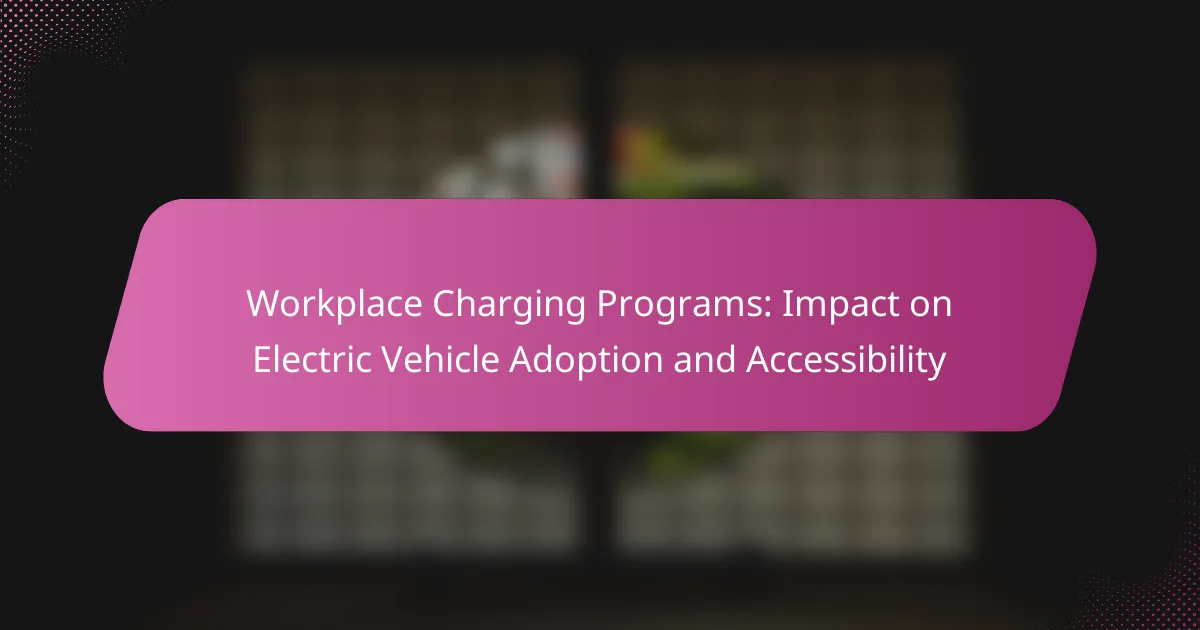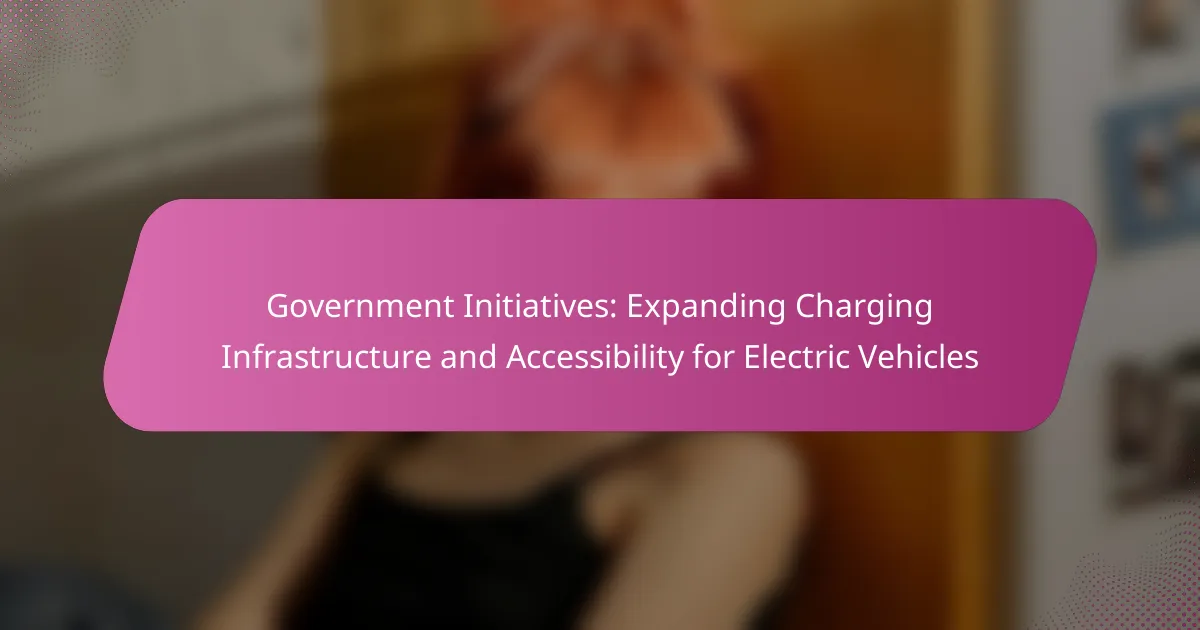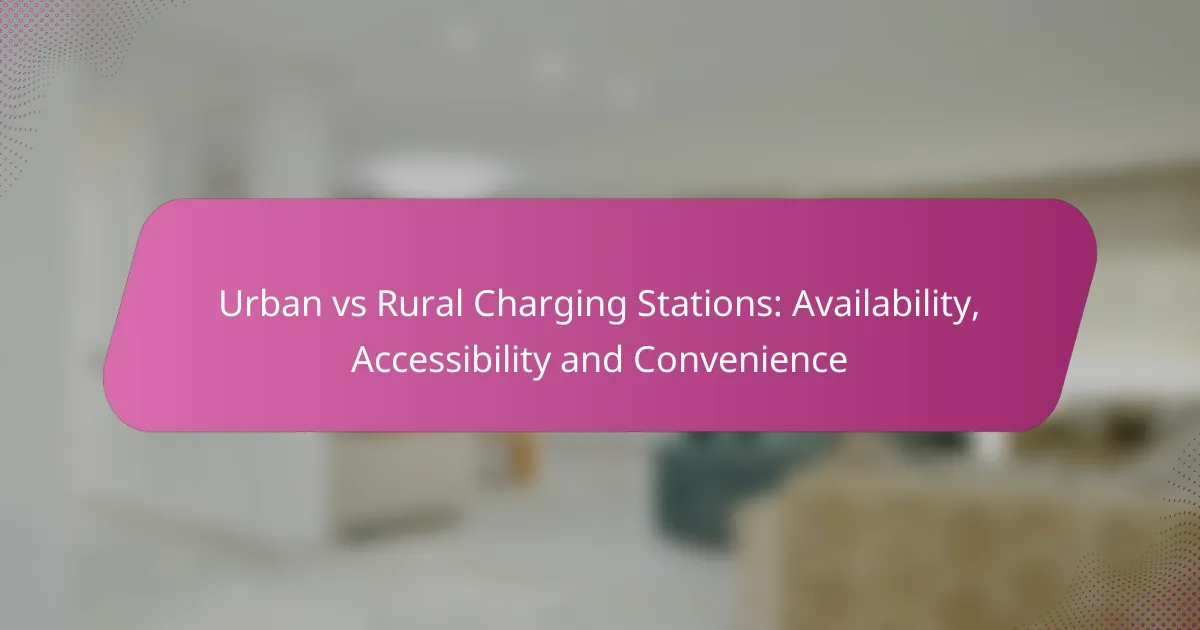Level 1, Level 2, and DC Fast Charging Stations vary in charging speed, power output, and installation requirements, making it essential for electric vehicle (EV) users to understand these differences. Each type of station offers unique benefits suited to different driving habits and charging needs, allowing users to select the most appropriate solution for their lifestyle. By considering factors such as charging speed and installation costs, EV owners can optimize their charging experience.
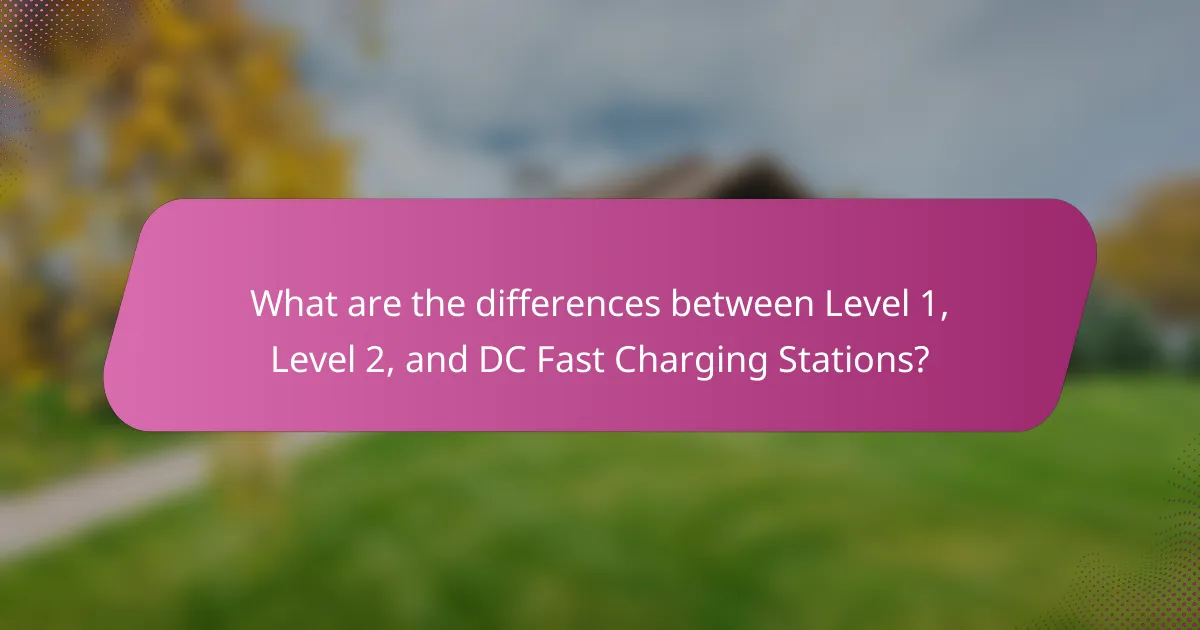
What are the differences between Level 1, Level 2, and DC Fast Charging Stations?
Level 1, Level 2, and DC Fast Charging Stations differ primarily in charging speed, power output, installation needs, and cost. Understanding these differences helps users choose the right charging solution for their electric vehicles (EVs) based on their specific needs and circumstances.
Charging speed comparison
Charging speed varies significantly among Level 1, Level 2, and DC Fast Charging Stations. Level 1 chargers typically provide around 2 to 5 miles of range per hour, making them suitable for overnight charging at home. Level 2 chargers offer faster charging, delivering about 10 to 60 miles of range per hour, ideal for home or public charging stations. DC Fast Chargers can add 60 to 100 miles of range in just 20 to 30 minutes, making them perfect for long-distance travel.
Power output specifications
Power output is another key difference. Level 1 chargers usually operate at 120 volts and provide up to 1.4 kW. Level 2 chargers, on the other hand, operate at 240 volts and can deliver between 3.3 kW to 19.2 kW, depending on the model. DC Fast Chargers are the most powerful, typically ranging from 50 kW to 350 kW, allowing for rapid charging of EV batteries.
Installation requirements
Installation requirements vary based on the charger type. Level 1 chargers can often be plugged into standard household outlets, requiring minimal installation. Level 2 chargers may need dedicated circuits and professional installation, which can involve electrical upgrades. DC Fast Chargers require significant infrastructure, including high-voltage power sources and specialized equipment, making their installation more complex and costly.
Cost differences
The cost of charging stations varies widely. Level 1 chargers are generally the most affordable, often costing less than $500. Level 2 chargers can range from $500 to $2,500, depending on features and installation costs. DC Fast Chargers are the most expensive, with prices ranging from $10,000 to over $40,000, factoring in installation and infrastructure needs.
Use case scenarios
Choosing the right charging station depends on specific use cases. Level 1 chargers are best for homeowners who can charge overnight and have limited driving needs. Level 2 chargers suit users who need faster charging at home or work, especially for daily commutes. DC Fast Chargers are ideal for commercial locations or highway rest stops, where quick turnaround times for long-distance travelers are essential.

What are the benefits of each charging station type?
Each type of charging station offers distinct benefits tailored to different user needs and circumstances. Understanding these advantages helps in selecting the most suitable option for electric vehicle (EV) charging.
Level 1 benefits
Level 1 charging stations utilize standard 120-volt outlets, making them widely accessible for home use. They are ideal for overnight charging, providing a convenient solution for daily commuters who drive short distances.
One of the main benefits of Level 1 charging is its low cost, as it requires no special equipment beyond a standard outlet. However, charging times can be lengthy, often taking 8 to 12 hours to fully charge an EV, which may not be suitable for all users.
Level 2 benefits
Level 2 charging stations operate on 240 volts, significantly reducing charging time compared to Level 1. They can fully charge most EVs in 4 to 6 hours, making them suitable for home installations or public charging locations.
These stations are often found in commercial settings and can provide a faster turnaround for drivers. While the installation cost is higher than Level 1, the efficiency and convenience they offer can justify the investment for frequent EV users.
DC Fast Charging benefits
DC Fast Charging stations provide rapid charging capabilities, allowing EVs to reach 80% charge in as little as 20 to 30 minutes. This is particularly beneficial for long-distance travel, where quick stops are essential.
These stations are typically located along highways and in urban areas, making them ideal for road trips. However, they may come with higher costs per charge compared to Level 1 and Level 2 options, and not all EVs are compatible with DC Fast Charging, so users should check their vehicle specifications before relying on this option.

How do I choose the right charging station for my needs?
Choosing the right charging station depends on your vehicle’s charging capabilities, your daily driving habits, and where you plan to charge. Consider factors like charging speed, installation costs, and available locations to find the best fit for your lifestyle.
Factors to consider
When selecting a charging station, evaluate the charging speed you require. Level 1 chargers are suitable for overnight charging at home, while Level 2 chargers are ideal for quicker charging at home or public locations. DC Fast Charging stations are best for long trips, providing significant charge in a short time.
Additionally, consider your vehicle’s compatibility with different charging standards. Most electric vehicles (EVs) support Level 1 and Level 2 charging, but not all can utilize DC Fast Charging. Check your vehicle’s specifications to ensure compatibility.
Cost-effectiveness analysis
Cost is a crucial factor in choosing a charging station. Level 1 chargers are typically the least expensive, often requiring only a standard outlet installation. Level 2 chargers involve higher installation costs but offer faster charging, making them more cost-effective for regular use.
DC Fast Charging stations, while providing rapid charging, often come with higher usage fees. Analyze your charging habits to determine if the convenience of faster charging justifies the additional costs. For occasional long trips, the investment may be worthwhile.
Location-based recommendations
Your location significantly influences the type of charging station you should choose. If you live in an urban area with access to public charging infrastructure, a Level 2 or DC Fast Charging station may be more beneficial. These options allow for quick top-ups during errands or work commutes.
In rural areas, where charging stations may be sparse, a Level 1 charger at home might be sufficient for daily needs. Ensure you have a reliable charging solution that aligns with your driving patterns and local charging availability.

What are common use cases for Level 1, Level 2, and DC Fast Charging?
Level 1, Level 2, and DC Fast Charging stations serve different needs based on charging speed and location. Level 1 is ideal for home use, Level 2 suits both residential and commercial settings, while DC Fast Charging is best for quick public charging during travel.
Residential use cases
Level 1 charging is often used in residential settings, where electric vehicle (EV) owners can plug their cars into a standard household outlet. This method is convenient for overnight charging, providing about 3-5 miles of range per hour, making it suitable for daily commuting needs.
Level 2 chargers are also popular in homes, offering faster charging speeds of 10-60 miles of range per hour. Installing a Level 2 charger at home typically requires a dedicated circuit and may cost between $500 and $2,000, depending on installation complexity.
Commercial use cases
Level 2 charging stations are frequently found in commercial settings, such as parking lots, shopping centers, and workplaces. They provide a balance of charging speed and convenience, allowing employees and customers to charge their vehicles while they shop or work.
DC Fast Charging stations are increasingly being adopted by businesses looking to attract EV drivers. These stations can charge a vehicle to about 80% in 30 minutes, making them ideal for locations near highways or travel routes where quick stops are essential.
Public charging infrastructure
Public charging infrastructure primarily utilizes Level 2 and DC Fast Charging stations to support the growing number of electric vehicles on the road. Level 2 stations are often located in urban areas, providing accessible charging options for residents without home charging capabilities.
DC Fast Charging stations are strategically placed along major highways and travel corridors, allowing long-distance EV travel. These stations are crucial for reducing range anxiety, enabling drivers to recharge quickly and continue their journeys with minimal downtime.
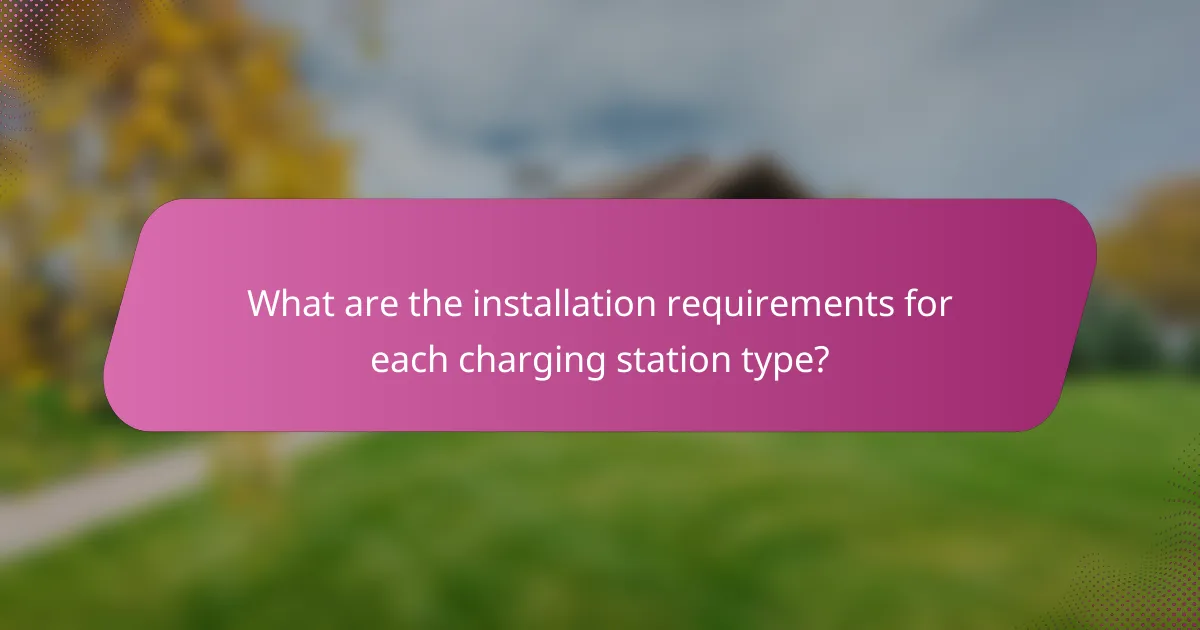
What are the installation requirements for each charging station type?
Installation requirements for Level 1, Level 2, and DC Fast Charging stations vary significantly based on electrical needs, space, and local regulations. Understanding these factors is crucial for effective planning and deployment of charging infrastructure.
Electrical infrastructure needs
Level 1 charging stations typically require a standard 120-volt outlet, making them the easiest to install in residential settings. Level 2 stations need a 240-volt outlet, which may require electrical upgrades in older homes or buildings. DC Fast Charging stations demand substantial electrical infrastructure, often needing three-phase power and dedicated transformers, making them more complex and costly to install.
When planning installations, consider the existing electrical capacity and potential upgrades. For example, a Level 2 charger may require a dedicated circuit, while a DC Fast Charger might necessitate a complete electrical assessment to ensure compatibility with local grid capabilities.
Space considerations
Level 1 chargers can be installed in small spaces, such as garages or driveways, due to their minimal footprint. Level 2 chargers require more space, especially if multiple units are installed, as they need room for parking and access. DC Fast Charging stations require significant space for the charger itself and often need additional room for vehicle maneuvering and queuing.
When selecting locations, ensure there is adequate space for both the charger and the vehicles that will use it. For instance, commercial installations should consider customer flow and accessibility to maximize usage.
Permitting and regulations
Installing any type of charging station typically requires adherence to local building codes and regulations. Level 1 installations may have fewer requirements, while Level 2 and DC Fast Charging stations often need permits due to their higher electrical demands. Regulations can vary widely by region, so it’s essential to consult local authorities before proceeding.
Be prepared for inspections and compliance checks, especially for larger installations. Engaging with a licensed electrician familiar with local codes can streamline the permitting process and ensure all safety standards are met.

